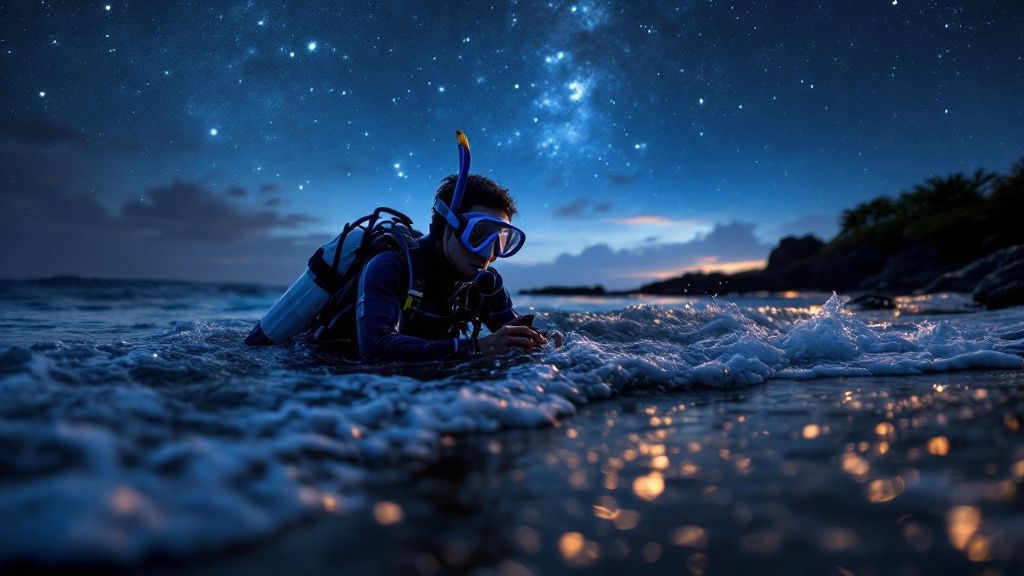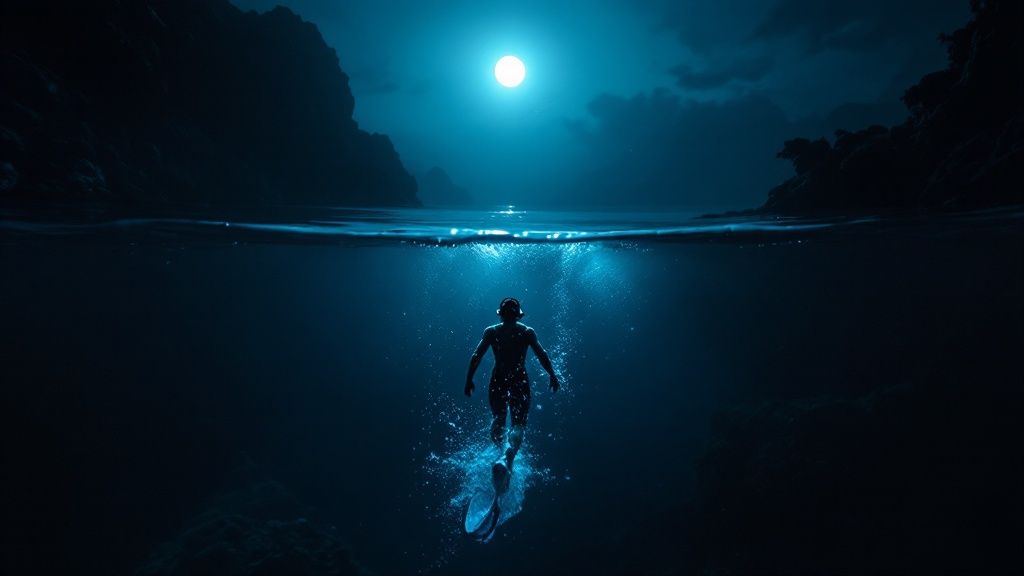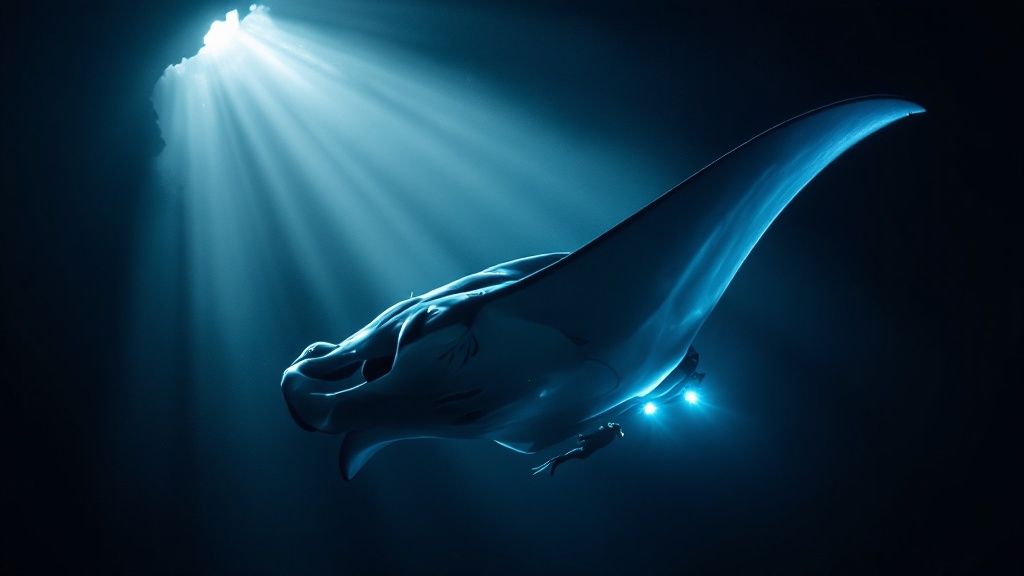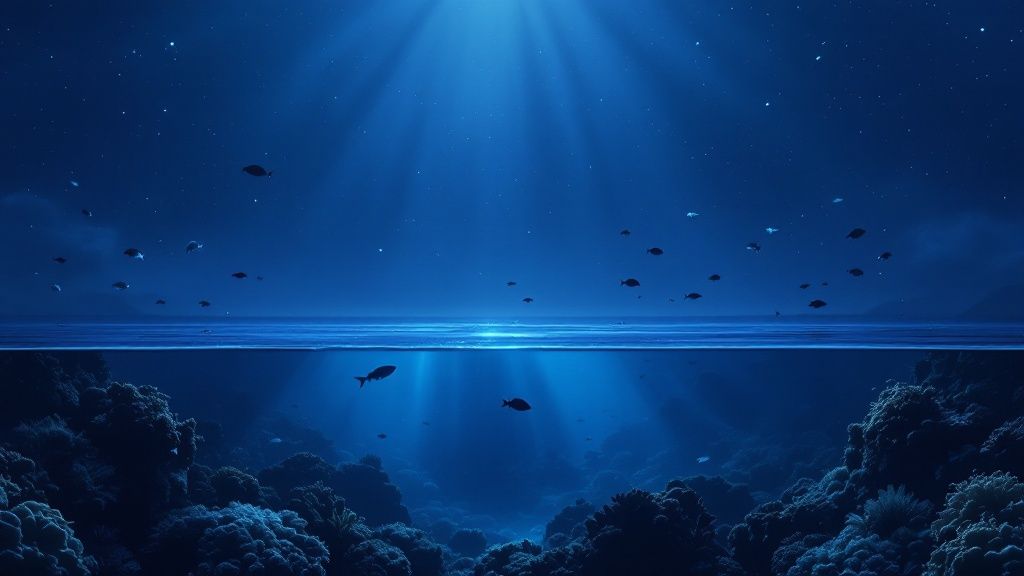The Magic of Big Island Manta Ray Night Snorkeling

Imagine floating on the calm ocean under a starlit sky, the only sound the gentle rhythm of the waves. Suddenly, a graceful manta ray emerges from the darkness, its giant wings gliding through the water. This is the magic of a Big Island manta ray night snorkel. It's an experience that draws visitors from all over the world.
This unique adventure blends excitement and tranquility, creating a truly unforgettable encounter. The darkness heightens your senses and anticipation. Specialized lights attract plankton, bringing in the manta rays, who perform captivating acrobatic displays as they feed.
The interplay of light and shadow, combined with the close proximity to these gentle giants, creates a truly magical atmosphere. Many visitors describe the experience as almost spiritual, and often rank it as the highlight of their Hawaiian vacation. Interested in learning more? Learn more about this magical experience.
Why Big Island Manta Ray Night Snorkels Are So Special
The Big Island is known for its exceptional manta ray viewing opportunities. One reason is the consistently high success rate of sightings. Operators like Jack's Diving Locker report an 85-90% success rate, showcasing the ideal conditions.
This consistency is due to the calm, clear waters around the island, which offer excellent visibility. Seasonal plankton blooms further enhance the chances of encountering these magnificent creatures. You can find more detailed statistics here. The moon phases also play a role, influencing visibility and manta ray feeding behavior.
The Big Island is fortunate to have resident populations of manta rays, not just seasonal visitors. This means these gentle giants can be observed year-round, although certain seasons offer better visibility and calmer waters. This allows researchers and tour operators to identify and track individual manta rays, increasing our understanding of them.
Choosing the Right Tour Operator
Given the popularity of Big Island manta ray night snorkeling, choosing the right tour operator is important. Companies such as Kona Honu Divers, Manta Ray Night Snorkel Hawaii, Kona Snorkel Trips, and Captain Cook Snorkeling Tours all offer variations on the experience.
Look for operators that prioritize sustainable practices and small group sizes for a more intimate and less intrusive experience. This allows for a deeper connection with the manta rays and a greater appreciation for their natural behavior.
Preparing for Your Adventure
Proper preparation is key to maximizing your enjoyment. Before your trip, watch videos showcasing the experience, like these: Video 1, Video 2, and Video 3. These offer a glimpse of what awaits and can ease any pre-trip nerves.
Consider bringing your own well-fitting snorkel gear for optimal comfort, although most operators provide equipment. Remember that evenings on the water can be cool, so pack a light sweater or towel. These simple steps will ensure you're comfortable and ready to embrace the magic of this unique encounter.
Understanding the Graceful Giants: Manta Ray Behavior

Manta rays, the ocean's graceful giants, exhibit fascinating behaviors and biological traits that make the Big Island manta ray night snorkel a truly special experience. These intelligent animals are filter feeders, consuming large amounts of plankton.
This feeding behavior is central to the night snorkel experience. Tour operators ethically use lights to attract plankton, creating a mesmerizing display for snorkelers. This allows for close-up views of the manta rays' acrobatic feeding maneuvers. The experience blends adventure and education, offering a unique glimpse into the underwater world. Learn more about why the Big Island manta ray night snorkel is so popular.
Manta Ray Biology and Lifespan
Manta rays are known for their impressive size, with wingspans reaching up to 20 feet. Their lifespan is also remarkable, often extending for several decades. This longevity provides researchers with opportunities for long-term study and observation, deepening our understanding of these creatures. For more information about when to see these magnificent animals, check out What is the best time of year to see manta rays in Kona?.
Cognitive Abilities and Interactions with Humans
Research suggests that manta rays possess remarkable cognitive abilities. They are thought to be capable of recognizing individual humans, showcasing an intelligence that sets them apart from many other fish species. Their apparent curiosity towards snorkelers adds a special dimension to the encounter.
This interaction fosters a unique connection between humans and these gentle giants. Their inquisitive nature enhances the already magical experience.
Conservation Challenges
Despite their size and grace, manta rays face significant conservation challenges. Slow reproductive rates and the risk of bycatch in fishing nets pose threats to their populations. Acknowledging these challenges elevates the Big Island manta ray night snorkel from a mere activity to a call for action.
It underscores the vital importance of marine conservation and our shared responsibility to protect these magnificent creatures. By supporting sustainable tour operators like Kona Honu Divers, Manta Ray Night Snorkel Hawaii, Kona Snorkel Trips, and Captain Cook Snorkeling Tours, visitors actively participate in manta ray preservation. These businesses prioritize the well-being of the manta rays and contribute to their long-term survival. This awareness transforms the Big Island manta ray night snorkel into a meaningful connection with the natural world.
Prime Viewing Spots: Where to Find Big Island Mantas

The Big Island offers incredible opportunities for a Big Island manta ray night snorkel. Two locations consistently impress: Manta Village (Keauhou Bay) and Manta Heaven (Garden Eel Cove). Each spot has its own unique charm, so understanding their differences will help you plan the perfect manta ray encounter.
Manta Village: The Heart of Manta Activity
South of Kona in Keauhou Bay, Manta Village is famous for its high manta ray sighting rates. Operators often report a success rate exceeding 90%. The calm, sheltered waters of the bay create ideal viewing conditions. The nearby Sheraton Kona Resort's lighting attracts plankton, the manta rays' main food source, further enhancing the chances of a memorable sighting.
Manta Heaven: A Larger Spectacle
North of Kona, off the coast by the airport, lies Manta Heaven (also called Garden Eel Cove). While sightings are slightly less frequent than at Manta Village, Manta Heaven offers the potential for a truly breathtaking display. On a good night, you might be treated to a mesmerizing underwater ballet of multiple manta rays feeding at once.
To help you choose the right spot, we've put together a comparison table:
Big Island Manta Ray Viewing Locations Compared: A comprehensive comparison of the two primary manta ray viewing spots on Hawaii's Big Island.
| Features | Manta Village (Keauhou Bay) | Manta Heaven (Garden Eel Cove) |
|---|---|---|
| Location | South of Kona | North of Kona (offshore from airport) |
| Sighting Consistency | Very High (90%+) | High, but slightly less than Manta Village |
| Potential Number of Mantas | Usually fewer individuals | Potential for larger groups |
| Water Conditions | Calm and sheltered | Can be slightly more open ocean |
| Boat Ride | Generally shorter | Slightly longer boat ride |
As you can see, both locations offer unique advantages. Manta Village provides more predictable sightings, while Manta Heaven offers the possibility of a more impressive, multi-manta spectacle.
Choosing the Right Spot For You
So, how do you choose? If you prioritize a near-guaranteed sighting and calmer waters, Manta Village is the perfect choice. If the chance to see a larger number of manta rays excites you, and you don't mind a slightly longer boat trip, then Manta Heaven is the better option.
This choice also influences your tour operator selection. For those staying near Kona, Kona Honu Divers provides convenient departures. Other well-regarded operators include Manta Ray Night Snorkel Hawaii, Kona Snorkel Trips, and Captain Cook Snorkeling Tours. Each company has different specialties and preferred locations, so researching their offerings will ensure the best fit for your manta ray adventure.
Beyond the Main Attractions: Exploring Lesser-Known Spots
Beyond the popular Manta Village and Manta Heaven, quieter viewing spots exist along the Kohala Coast, north of Kona near Kawaihae Harbor. These less-traveled locations offer smaller groups and fewer boats, creating a more intimate experience with the manta rays. While the manta ray activity can be less predictable, these hidden gems appeal to those seeking a tranquil setting away from the crowds. Consider these spots if you prioritize a unique experience over guaranteed sightings. The best spot for your Big Island manta ray night snorkel ultimately depends on your priorities and comfort level.
Selecting Your Perfect Manta Ray Experience Provider

Choosing the right tour operator for your Big Island manta ray night snorkel is key to an unforgettable experience. Several factors contribute to a great tour, but some truly elevate an experience from good to exceptional. These factors go beyond the basics, ensuring not only a thrilling adventure but also a responsible and educational encounter. You might be interested in learning how Kona Honu Divers Was Voted the Best Dive Operator in Kona, Hawaii.
Safety and Sustainability: Pillars of a Responsible Tour
Safety should always be the top priority. Look for operators with certified guides trained in emergency procedures and equipped with proper safety gear. Sustainable practices are also essential. Responsible operators follow guidelines that minimize disturbances to the manta rays and their habitat.
These guidelines often involve maintaining a respectful distance and avoiding any contact. Reputable operators educate guests about the importance of not touching the manta rays, as this can harm their protective mucous layer.
Guide Expertise: Enhancing Your Encounter
A knowledgeable guide significantly enhances the Big Island manta ray night snorkel experience. Skilled guides can identify individual manta rays, explain their fascinating behaviors, and answer any questions. They can also help you get the best views for photos and videos.
Group Size and Equipment Quality
Smaller group sizes often lead to a more personalized and intimate experience. With fewer people in the water, you'll have more opportunities for close encounters and better interaction with your guide.
Quality equipment also plays a vital role in your comfort and enjoyment. Well-maintained snorkel gear, wetsuits, and flotation devices make a big difference in how much you enjoy your time in the water.
The Importance of Conservation
The Big Island's manta ray night snorkel tours contribute significantly to scientific research and conservation. Tour operators often document individual manta rays, which provides valuable data for researchers tracking their movements and health.
In Kona, for instance, as many as 250 individual manta rays have been identified, allowing operators to recognize and monitor specific individuals. This detailed documentation supports conservation efforts and ensures high sighting rates for visitors. Learn more about manta ray statistics.
Choosing the Right Operator for You
To help you select the best operator, we’ve compiled a comparison table showcasing key features of some popular choices.
The table below provides a detailed analysis of recommended Big Island manta ray night snorkel providers. It highlights key features such as group size, experience level required, equipment quality, and the operator’s commitment to conservation. It also showcases any unique features offered.
| Tour Operator | Group Size | Experience Level | Equipment Quality | Conservation Commitment | Unique Features |
|---|---|---|---|---|---|
| Kona Honu Divers | Small | Beginner – Advanced | High | Strong | Focus on education and personalized experience |
| Manta Ray Night Snorkel Hawaii | Medium | Beginner – Intermediate | Good | Moderate | Offers various tour times and packages |
| Kona Snorkel Trips | Small | Beginner – Advanced | High | Strong | Specializes in small group tours |
| Captain Cook Snorkeling Tours | Medium | Beginner – Intermediate | Good | Moderate | Combines manta ray snorkeling with other activities |
As you can see, each operator offers a slightly different experience. Consider what's most important to you, whether it's small group size, a focus on conservation, or specific equipment.
Remember to book in advance, especially during peak season. Several reputable operators, including the ones listed above, offer fantastic Big Island manta ray night snorkel tours.
Your Night With Mantas: From Boat to Breathtaking Moments
Your Big Island manta ray night snorkel adventure begins well before you enter the water. The excitement starts with the pre-trip briefing. Your guides will outline the evening's plan, review safety procedures, and share fascinating facts about the majestic manta rays. This builds anticipation for the incredible experience that awaits. When organizing your manta ray snorkel trip, consider scheduling carefully, much like efficient dive centre scheduling. Proper planning ensures a smooth and enjoyable adventure.
Boarding and Briefing: Setting the Stage
Next, you'll board the boat. These are typically comfortable vessels equipped with all the necessary snorkeling gear. The short ride to the viewing site offers a chance to enjoy stunning sunset views and chat with your fellow snorkelers. Guides will point out interesting landmarks and offer final tips to make the most of your manta ray encounter. This transition time allows any pre-snorkel nerves to settle as the anticipation grows.
Entering the Water: A Magical Transformation
Once you arrive at the designated snorkel spot, like Manta Village or Manta Heaven, you'll gently slip into the water. The initial feeling of the dark ocean at night can be a surprising contrast to daytime snorkeling. However, the strategically placed lights create a magical, almost ethereal atmosphere. These lights attract plankton, the manta rays' main food source, setting the stage for a breathtaking spectacle.
The Manta Ray Ballet: A Dance of Grace and Light
The real magic begins when the manta rays arrive. These gentle giants, some with wingspans reaching 16 feet, glide effortlessly through the illuminated water. Their movements are a mesmerizing ballet of grace and power. They perform intricate loops and turns, often coming within inches of the snorkelers, as they feed on the plankton. It's a truly immersive experience, offering an intimate glimpse into their natural behavior. For more in-depth knowledge about these magnificent creatures, explore this resource: Learning more about manta rays in Kona.
Maximizing Your Experience: Tips From the Pros
For the best views, experienced snorkelers recommend positioning yourself near the lights. Keeping your body still minimizes disturbance to the manta rays, allowing for closer observation. Maintain a respectful distance and appreciate these creatures in their natural habitat. Some tour operators provide flotation devices, which can help you stay stationary and extend your viewing time. While capturing this experience is tempting, remember that the low-light conditions make photography challenging. Focus on enjoying the moment and marveling at these gentle giants. The guides are also skilled at helping nervous swimmers feel comfortable in the night water, ensuring everyone has a safe and memorable encounter.
Returning to Shore: A Lingering Magic
As the night ends, you'll return to the boat, buzzing with the excitement of your encounter. The magic of the experience lingers long after you leave the water, with many describing it as their most unforgettable Hawaiian memory. The trip back to shore provides a final opportunity to reflect on the evening’s wonders and share stories with new friends. The Big Island manta ray night snorkel truly is an unforgettable experience.
Preparing for an Unforgettable Manta Ray Encounter
Getting ready for a Big Island manta ray night snorkel is more than just grabbing your swimsuit. A bit of planning can greatly improve your comfort and enjoyment, making an amazing experience truly unforgettable. This involves thinking about everything from seasickness to your camera settings.
Essential Gear and Comfort Items
Most tour operators provide basic snorkel gear. However, bringing your own well-fitting mask and snorkel increases comfort and hygiene. Even in Hawaii, evenings on the water can get chilly. Pack a light sweater or towel for after your swim. For lodging recommendations, check out this helpful resource: Learn more about where divers stay on the Big Island.
Combating Seasickness
If you are prone to seasickness, take precautions. Non-drowsy motion sickness medication taken an hour before your tour can be helpful. Motion sickness patches or acupressure wristbands are also effective options. Consider choosing a tour operator with a shorter boat ride, such as those departing from Keauhou Bay for Manta Village.
Acclimatizing to Night Snorkeling
For first-time night snorkelers or those nervous about the dark, acclimating beforehand can be beneficial. Watching videos of previous manta ray night snorkels, like the ones above, offers a preview and can ease apprehension. Practicing with your snorkel gear in a pool or calm shallows during the day can build confidence.
Pre-Trip Conditioning for Swimmers
Even if you're an average swimmer, pre-trip conditioning improves stamina and enjoyment. Regular swimming or water aerobics in the weeks before your snorkel builds endurance. This allows you to focus on the manta rays, not on physical exertion.
Camera Settings and Photography Tips
Capturing the magic of manta rays in low light can be tricky. If you bring an underwater camera or GoPro, practice with its settings in a darkened pool beforehand. A red filter can help compensate for the blue hues of underwater lighting. Remember to prioritize enjoying the moment over perfect photos.
Food and Hydration
What you eat before your trip affects your comfort on the water. Avoid heavy, greasy meals that might contribute to seasickness. Choose light, easily digestible foods and stay hydrated throughout the day.
Preparing Children and Anxious Snorkelers
Preparing children or anxious individuals mentally is key. Talking through the experience step-by-step and emphasizing the gentle nature of manta rays can ease fears. Allow them to ask questions and address their concerns for a more comfortable and enjoyable experience.
Timeline for Preparation
Book your Big Island manta ray night snorkel well in advance, especially during peak season. In the weeks leading up to your trip, gather your gear, practice snorkeling, and address any seasickness concerns. The day before, review the tour operator's instructions, prepare your camera, and choose appropriate clothing. On the day of your snorkel, eat a light meal, stay hydrated, and arrive on time, ready for an extraordinary encounter.
